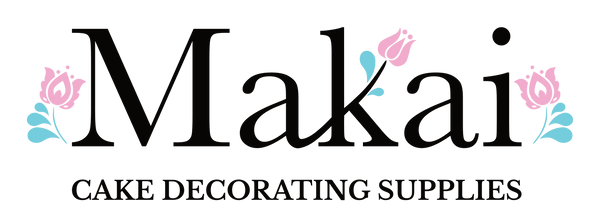
How to Get a 5-Star Food Hygiene Rating as a Home-Based Baker in the UK
Share
By Makai Cake Decorating Supplies
If you're baking and selling cakes from home, you’ve probably heard of the Food Hygiene Rating Scheme (FHRS). But what exactly does it take to get 5 stars — and do you still need to prepare, even if your local council says no inspection is needed?
In this guide, we’ll walk you through everything you need to know — including paperwork, hygiene, and real-world experiences from fellow bakers.
If you're aiming to run a trusted cake business, this is for you.
What Is the FHRS?
The Food Hygiene Rating Scheme is used across the UK to assess food businesses on:
- Food handling & hygiene
- Structure and cleanliness
- Management & paperwork
Scores range from 0 to 5, with 5 meaning “very good”. You’ll receive your rating following an inspection from your local council’s Environmental Health Officer (EHO).
Even if you’re just decorating cakes at home, you’re still considered a food business and expected to follow these rules — even if you haven’t been inspected (yet).
Do I Need to Prepare If I Haven’t Been Inspected?
Yes — absolutely.
Many councils do not inspect low-risk businesses immediately, especially if you only make cakes or sweet bakes. But you still have legal responsibilities.
If a complaint is made or your business grows, an inspection could happen at any time — and unprepared businesses risk a low score or even penalties.
If you're not sure where to start, we recommend reading:
👉 How to Start a Home Baking Business in the UK – Legal Steps & Practical Tips
What You Need to Do to Get 5 Stars
1. Complete a Food Safety Training
Most 5-star bakers hold a Level 2 Food Hygiene Certificate. It shows you understand food safety basics — a common expectation for home bakers, even if not strictly required by law.
Once completed, print and store your certificate.
You can even include it in your customer handover process using our Cake Handover Disclaimer.
2. Fill Out the ‘Safer Food, Better Business’ (SFBB) Pack
This official paperwork is the foundation of your food safety system. It includes:
- Cleaning schedule
- Daily diary
- Allergy records
- Supplier list
- Food safety methods
If you’d like a more cake-specific version, check out our simplified SFBB-style templates for cake decorators.
3. Track Cleaning and Storage
Keep a cleaning schedule in a visible place. Make sure:
- Surfaces, tools, boards and brushes are cleaned between orders
- Fridges and storage boxes are regularly disinfected
- You use sanitisers that meet food hygiene standards
Need help planning your week? Try our Weekly Cake Planner for a structured approach.
4. Store Ingredients Separately and Safely
You don’t always need a second fridge — but you do need:
- Clear separation between business and personal food
- Raw ingredients at the bottom
- Ready-to-eat items at the top
Many home bakers also use labelled containers or separate drawers — an easy fix that shows organisation.
5. Document Allergen Information
Allergen labelling is a legal requirement. You must clearly record which of the 14 major allergens are present in each cake or topper.
Need help? Use our Allergy Labelling Template to make this part easy and accurate.
6. Have a Handwashing Station
A clean sink is fine, but it must have:
- Soap
- Hot & cold water
- Disposable towels
Some councils also ask that it’s used only for handwashing (not for food prep or dishwashing) during cake production.
7. Keep a Complaints & Corrections Log
Things happen — a delay, a missing topper, a smudged message. Instead of panicking, log the issue, the date, and what you did to fix it.
This shows you’re taking food safety seriously and builds customer trust too.
If you don’t already have one, check out our Refund & Complaint Policy Template — a great way to show professionalism.
8. Be Ready for Tiered Cakes & Dowels
If you make tiered cakes, you’ll need proper cake support — and your inspector may ask how you prevent collapse or contamination during stacking and delivery.
Not sure where to begin? Read our Guide to Using Cake Dowels or download the printable Cake Dowel Guide.
Real Advice from UK Cake Makers
“My council said I didn’t need an inspection, but I still filled in the SFBB and did the training. Two years later — surprise visit! Thankfully I was ready.”
— UK Home Baker, via Facebook
“I lost a star for missing paperwork, even though my kitchen was spotless.”
— Comment from a baking forum
Common Mistakes That Lower Your Rating
- No cleaning or allergy logs
- Pets in the kitchen
- Raw eggs stored above buttercream
- No proof of food safety training
- No handwashing set-up
- Incomplete SFBB
Final Checklist for 5 Stars
| ✅ Must-Have | 📎 Makai Resource |
|---|---|
| Food Hygiene Certificate | External course – print and store |
| SFBB Pack (filled out) | Cake-Specific SFBB Extract |
| Cleaning Schedule | Use the Weekly Planner for structure |
| Allergen Info | Allergy Labelling Template |
| Complaints Log | Refund & Complaint Policy Template |
| Tiered Cake Safety | Cake Dowel Guide & Dowel Products |
Want Help Getting Organised?
Download our Home Baker Hygiene Pack — designed specifically for home-based cake makers who want to stay inspection-ready.
It includes:
Editable cleaning & fridge logs
Printable allergen sheets
Inspection checklist
Cake-specific SFBB pages
Browse all Free Downloads or read more expert advice on the Blog.
